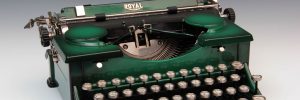By Sam Daleo
Read the full June 2013 issue of Viewpoints.
What do a Ford tri-motor airplane and a typewriter have in common? If the typewriter is the Royal portable currently on display in the visitor center, the answer is, “plenty.”
The Royal Typewriter Company was founded in Brooklyn, New York, in 1906, by E. B. Hess and Lewis C. Myers, with the financial backing of Thomas Fortune Ryan. Hess was one of the most prolific typewriter inventors ever, securing more than 200 patents over his lifetime. One of these patents was for an accelerating typebar, which required “less effort per tap,” giving the company its early trademark “light touch” slogan. The real desire of the company, however, was always to make their machines compact and easy to carry, unlike other heavy, cumbersome machines on the market at the time.
Royal’s first portable was manufactured in 1906. Though it had a low profile and a leather carrying case, at 22 pounds, this machine was not exactly “portable.” Sales were disappointing, causing the company to redirect its efforts toward large, desktop machines. It was not until 1926 that Royal came out with a truly portable design. The new portables incorporated all the features of larger machines, in a compact and stylish body. The Royal in the visitor center is one of these, produced between 1930 and 1934.
Royal’s debut into the portable typewriter market came years after the other leading typewriter companies of the time. To catch up, Royal’s flamboyant president, George Ed Smith, decided on a two-part advertising campaign. First, the focus would be on the nation’s fifteen million homes and the housewives who ran those households and made furnishing and decorating decisions. Smith would attract their attention with color. The new portables would be painted in a “duotone” paint scheme. A total of more than five hundred color combinations were used, in the hope of satisfying every taste and personality. There was even a black-on-black color scheme for the “ultra conservative housewife, or the women who did a great deal of formal entertaining.” We have a black-on-black in our collection.
The second part of the campaign was directed at the husbands, who actually paid for their wives’ decorating endeavors. To convince them that these new portables were not only beautiful, but rugged as well, Smith came up with a revolutionary idea. Royal would parachute the portables out of an airplane to dealers around the country. Smith felt that if the portables could survive a parachute drop, crated no differently than if they were going by truck or train, they would certainly be deemed rugged.
Enter the just-introduced Tri-motor airplane, built by the Ford Motor Company. It was the largest commercial airplane in the world and one that had definitely caught the public’s attention. Smith purchased a new Tri-motor for $75,000, named it the “Royal Air Truck,” and began his advertising campaign several hundred feet in the air, at a breathtaking speed of 110 mph. Eleven thousand portables were parachuted to Royal’s dealers, unpacked where they landed, and checked to see if they were in working condition. Only six machines out of the eleven thousand were damaged, thus proving the toughness of the little machines. Were husbands convinced? And how! Sales quite literally “took off.” Between 1926 and 1947, Royal sold 1,400,000 portables, not only catching its competitors but going on to become the world’s largest typewriter manufacturer.
[share title=”love it, share it!” socials=”facebook, twitter, google, pinterest, bookmark” ]


 Director’s Desk: Digital Detox
Director’s Desk: Digital Detox